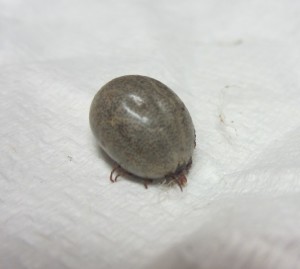Ticks are one of those pests that just gives you the heebie jeebies. You see one, and you feel like they’re all over you! Well there is good reason to be so grossed out by them. Ticks transmit a variety of nasty diseases that no one wants to get, including your pets!
The tick’s lifestyle is a bit different from the flea. Where the fleas like to jump on a host as an adult and live out its life on one animal, the tick will have a different host for each stage of its life. Ticks hatch from eggs into a larval stage, where they only have 6 legs (often referred to as seed ticks). They stay down on the ground and will grab on to the first warm-blooded animal that comes close enough to reach. Larval ticks often feed on smaller mammals such as mice or birds. Once they’re done feeding, usually after a few days, they fall off and molt into an eight-legged nymph stage. Nymphs will crawl up on blades of grass and hang off of it waiting for a host to brush by so they can grab on. They feed for a few days, and fall off of that host. They will molt into an adult stage, and find another host to feed on for a few days, then females will fall off and lay eggs before dying. The life cycle can take a couple years to complete.
Ticks can cause anemia, irritation or inflammation at the site of the bite, or paralysis from a neurotoxin produced by female ticks of several species. They can also transmit the diseases listed below. Click on the disease name to read more about it.
Lyme disease A vaccine is available for lyme disease.
Ehrlichiosis
Anaplasmosis
Rocky Mountain Spotted Fever
Cytauxzoonosis (aka: Bobcat Fever)
Hepatozoonosis
Ticks are hard to kill. Most tick products are designed to kill ticks and some are even designed to repel them as well, but this doesn’t mean you will never see a tick on your pet. Every time they go outside, especially in tall grass or wooded areas, they will be exposed to ticks. If your pet’s prevention takes a few hours to kill the ticks, which is often the case, you may see live ones on your pet when they first come inside. The key is that they have a preventative that will eventually kill them, because without it those ticks will attach, feed, transmit diseases, and go on to lay more eggs.
Check out this comparison chart for tick control products. Do not use products with DEET directly on your pets because it is toxic. It is always a good idea to check your pet for ticks after being in a wooded area, whether or not they are on a preventative. Ticks tend to attach in less heavily haired areas, such as around the head, feet or on their rear end under the tail. But they can be found anywhere!
To remove a tick, put rubbing alcohol on it and wait for a minute or 2. Then grab it firmly as close to the skin as possible without squeezing the tick, and pull up steadily. You can use your fingers or tweezers. Do not try to jerk it out quickly because the head may stay in the skin. Once the tick is out you can flush it down a toilet, or make sure it is dead before putting it in the trash can (or it might crawl back out!).
For more information:
Centers for Disease Control
Companion Animal Parasite Council
Dogs and Ticks



